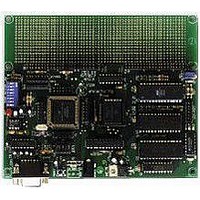CMD-711EX AXIOM, CMD-711EX Datasheet - Page 4

CMD-711EX
Manufacturer Part Number
CMD-711EX
Description
Microprocessor Development Tool
Manufacturer
AXIOM
Datasheet
1.CMD-711EX.pdf
(15 pages)
Specifications of CMD-711EX
Silicon Manufacturer
Freescale
Kit Contents
Board
Silicon Family Name
68HC11E
Silicon Core Number
MC68HC11E9FN, MC68HC11E20FN
Development Tool Type
Hardware - Eval/Demo Board
Lead Free Status / RoHS Status
Contains lead / RoHS non-compliant
SOFTWARE
There are many useful programs on the software disk that make developing your projects easier. You can download
the latest update to this disk free at any time from our web page at: http://www.axman.com.
The main programming interface to the CMD711-EX board is included as both a DOS program named AX11E.EXE
and a Windows program named AXIDE.EXE. The windows program is a 32-bit application that requires Windows 95
or greater. You can use the DOS utilities standalone or in a DOS window under Windows 3.1.
Both versions of the software communicate serially with the boards COM1 port and include a Terminal window for
interfacing with other programs running on the board, such as the buffalo monitor/debugger program.
Most communications programs will also work with the CMD711-EX board. Even the Terminal program in Windows
will do an adequate job. Communications settings should be set to 9600 baud, 1 start, 1 stop, 8 data, no parity.
See the README file for a complete listing of all programs and files on the disk.
TUTORIAL
This section should help you get started with the specifics of the CMD711-EX development process. Be sure to read
the rest of this manual as well as the documentation on the disk if you need further information.
The following sections take you through the complete development cycle of a simple "hello world" program. Since
the methods for using the DOS version of the software are almost identical to using the Windows version, only the
Windows version is used in this tutorial. You should however be able to substitute the DOS version of the
programming software AX11E.EXE and follow this tutorial without much difficulty.
Creating source code
The first step in any software development process is creating source code. You can write source code for the
CMD711-EX board using any language that compiles to 68HC11 instructions. Included on the software disk is a free
Assembler and also a freeware Basic compiler written by Karl Lunt. Inexpensive or free compilers are also available
for C and Forth languages.
You should write your source code using a standard ASCII text editor. Many powerful code editors are available or
you can use the free EDIT or NOTEPAD programs that come with your OS. Once your source code is written and
saved to a file, you can assemble or compile it to a Motorola S-Record (hex) format. This type of output file usually
has a .MOT or .HEX or .S19 file extension and is in a format that can be read by the programming utilities to be
programmed into the CMD711-EX board.
IT IS IMPORTANT to understand your development board's use of Memory and Addressing when writing source
code so you can locate your code at valid addresses. For example, when in "debug" mode, you should put your
Program CODE in External RAM. In assembly language, you do this with ORG statements in your source code. Any
lines following an ORG statement will begin at that ORG location, which is the first number following the word ORG,
for example: ORG $2000.
You must start your DATA (or variables) in a RAM location unused by your program, for example: ORG $1040.
When finished debugging, you must change these ORG statements so that your program is moved to a valid
EEPROM area - somewhere after hex D000. Do this by putting an ORG $D000 in front of your Program CODE.
Data may remain where it is or be moved down to internal RAM starting at ORG $0000. You must also program the
STACK register somewhere at the top of your available RAM, for example hex 1FF. Do this with this instruction as
the first instruction in your program code: LDS #$01FF.
A look at the example programs on the disk can make all of this clearer. If you're using a Compiler instead of an
assembler, consult the compiler documentation for methods used to locate your code and data.
4
















